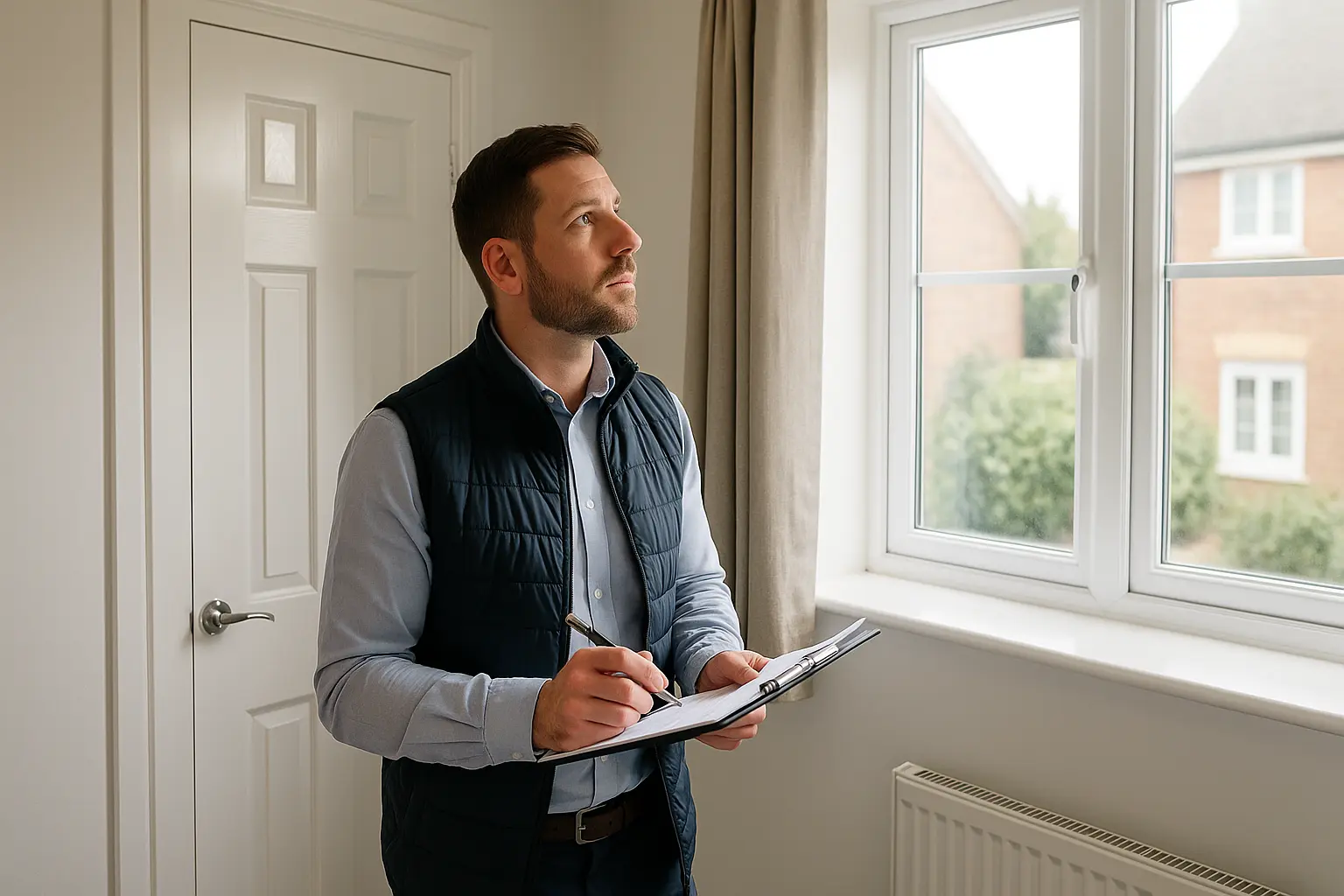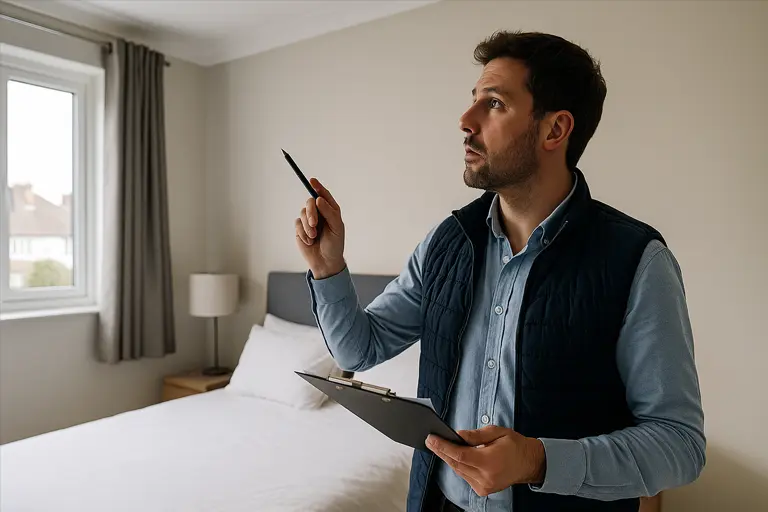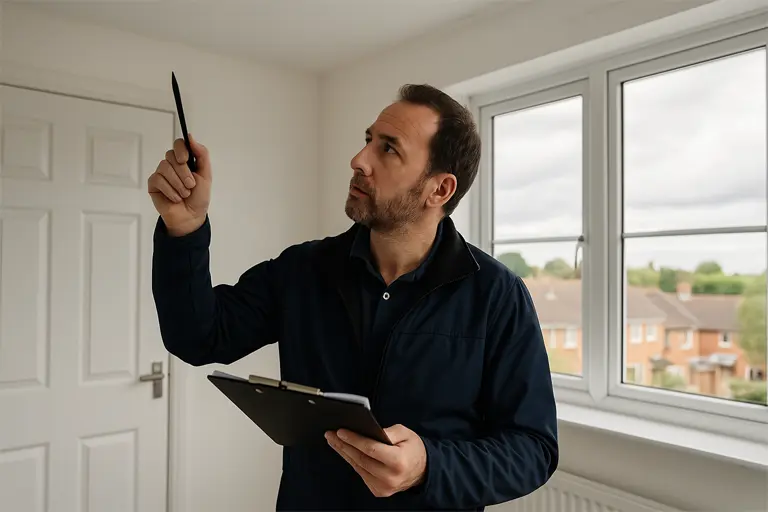As a landlord, your property is one of your most valuable assets, yet many don’t realise that neglecting regular inspections could cost them thousands in damages, insurance disputes, or even legal trouble.
A single unnoticed leak, unauthorised pet, or cannabis farm hidden in the loft could spiral into a serious issue. That’s where periodic property inspections come in.
Periodic inspections are more than just a box-ticking exercise, they are a legal safeguard, a relationship builder, and a risk management strategy. Done correctly, they keep your property in check, your tenants accountable, and your investment secure.
In this ultimate guide, we’ll cover everything you need to know:
✅ What a periodic inspection is (and isn’t)
✅ Legal access rights and tenant protections
✅ What to check, room by room
✅ How often to inspect (without crossing the line)
✅ Common mistakes landlords make
✅ And how to outsource inspections the smart way
We’ve even included tables, inspection checklists, and useful links, so you can leave with clarity and confidence.
Let’s begin with the basics.
A periodic property inspection is a routine mid-tenancy visit carried out by a landlord or letting agent to check on the overall condition, cleanliness, and compliance of a rental property.
Unlike a check-in or check-out report, both tied to the start or end of a tenancy, periodic inspections happen while tenants are still in residence. Their purpose isn’t to “catch tenants out,” but to proactively identify any issues before they spiral: damp patches, overdue maintenance, signs of unauthorised subletting, or even illegal activity.
Under UK law, landlords have a responsibility to maintain a safe and habitable property. But without regular inspections, that duty becomes almost impossible to fulfil. Issues like unnoticed leaks, gas appliance faults, or structural damage can worsen over time, costing thousands if not addressed early.
Periodic inspections serve three key goals:
- ✅ Preserve the value and safety of the property
- ✅ Protect both landlord and tenant with early detection
- ✅ Meet legal and insurance requirements for property upkeep
When conducted professionally and respectfully, with proper notice, they’re also a powerful way to maintain positive relationships with tenants and reduce costly disputes down the line.
Let’s take a closer look at how periodic inspections differ from other types of rental property assessments:
| Inspection Type | When It's Done | Purpose |
|---|---|---|
| Inventory Check | Before tenancy starts | Document property condition and contents before tenant moves in. |
| Check-In | On move-in day | Verify inventory and condition with tenant present. |
| Periodic Inspection | During tenancy | Check maintenance, safety, damage, and unauthorised activity. |
| Check-Out | At tenancy end | Compare to inventory to resolve deposit disputes. |

Periodic property inspections are more than just a box-ticking exercise. They play a critical role in protecting your property, safeguarding your investment, and ensuring tenants are living in a safe, well-maintained environment.
Whether you’re a hands-on private landlord or managing a portfolio through a letting agent, regular inspections can save you thousands, both in preventative maintenance and legal costs.
Here’s why they matter:
Preserve Property Value
Small issues left unchecked become expensive problems. A slow leak under the sink might turn into floor rot. A broken extractor fan could lead to damp and mould. Regular inspections help landlords:
- Spot damage early
- Prevent long-term deterioration
- Extend the lifespan of fixtures and fittings
- Maintain kerb appeal and rental value
Ensure Safety & Legal Compliance
Landlords in the UK have legal obligations under the Landlord and Tenant Act 1985, Housing Health and Safety Rating System (HHSRS), and other housing legislation. Inspections support compliance by checking:
- Smoke and carbon monoxide alarms
- Gas and electrical safety
- Fire exits and ventilation
- Structural issues or trip hazards
Failure to inspect could expose you to liability, especially if a tenant is injured or a safety fault leads to a serious incident.
Meet Insurance Policy Requirements
Many landlord insurance policies require regular property inspections to remain valid, particularly in long-term tenancies or for unfurnished or partially vacant properties.
If you ever need to make a claim for accidental or malicious damage, your insurer may ask for evidence of periodic visits.
✅ Inspections = compliance trail = claim success.
Create a Clear Paper Trail
A documented inspection history helps if disputes arise. From deposit disagreements to claims of disrepair, periodic reports:
- Prove you fulfilled your duty of care
- Help defend legal claims
- Support eviction or possession notices if required
Reinforce Tenant Accountability
When tenants know the property is being inspected routinely, they’re more likely to:
- Report maintenance issues promptly
- Avoid unauthorised modifications or subletting
- Maintain better cleanliness and hygiene standards
- Respect tenancy agreement terms
It’s not about policing; it’s about setting expectations.
Build Trust and Prevent Miscommunication
Inspections offer a rare opportunity to engage with tenants face-to-face. When done with empathy and professionalism, they can:
- Uncover hidden concerns before they escalate
- Reduce tenant anxiety about landlord responsiveness
- Strengthen cooperation and long-term retention
What Should Be Checked During a Periodic Inspection?
A well-conducted periodic inspection goes far beyond a quick walkthrough. It’s a structured, room-by-room assessment of the property’s condition, safety features, hygiene standards, and compliance risks, designed to give landlords peace of mind and provide a paper trail in case of future disputes.
Whether you’re inspecting yourself or outsourcing to a professional service, a clear checklist ensures nothing is missed, and every box is ticked.
Here’s what a comprehensive periodic inspection should include:
🛋️ General Interior Checks
- Condition of walls, ceilings, and floors (e.g. cracks, peeling paint, stains)
- Evidence of damp, mould, or condensation
- Signs of smoking, damage, or unauthorised pets
- Windows and doors: security, operation, and seals
- Heating and hot water systems: working condition
- Cleanliness and general upkeep
- Smoke alarms and carbon monoxide detectors: presence and testing
- Signs of overcrowding or subletting
- Unusual smells (e.g. damp, drugs, decay)
🍽️ Kitchen Checks
- Condition of worktops, sinks, taps, and cupboards
- Evidence of leaks under the sink
- Cooker, oven, extractor fan: cleanliness and function
- Fire blanket and fire extinguisher (if supplied)
- Hygiene level: grease buildup, food waste, pest risk
🚿 Bathroom Checks
- Taps, shower, toilet, and drainage all functioning
- Signs of water damage, damp or black mould
- Ventilation (window or extractor fan) working properly
- Silicone and tile grout condition
- Overall hygiene
🛏️ Bedroom & Living Areas
- Flooring condition (carpets, laminate, etc.)
- Curtain rails, blinds, and light fittings secure
- Furniture damage (if furnished)
- Signs of excessive wear or misuse
🔒 Health, Safety & Compliance
- Fire doors (if applicable): close and latch properly
- Emergency lighting or signage (HMO properties)
- Meter cupboards: signs of tampering
- Electrical sockets: visible damage, scorch marks
- Fuse box and boiler areas clear and accessible
- Loft or attic access: signs of unauthorised use (e.g. hidden grow setups)
🌿 Exterior (if applicable)
- Front and rear doors: locks secure, no forced entry signs
- Garden: maintained or overgrown, rubbish buildup
- External lighting, windows, fascia boards, guttering
- Signs of pest activity
- Bin storage and waste management
| Area | What to Check |
|---|---|
| General Interior |
- Walls, ceilings, floors: damage, cracks, stains - Evidence of damp, mould, condensation - Windows and doors: seals, locks, ease of use - Heating and hot water systems - Cleanliness and hygiene - Smoke/CO detectors: presence and function - Signs of overcrowding, smoking, or pets - Unusual odours or tampering |
| Kitchen |
- Sink, taps, cupboards: leaks, damage - Cooker, oven, extractor: cleanliness, working order - Fire blanket/extinguisher (if supplied) - Hygiene, grease buildup, pest risks |
| Bathroom |
- Taps, toilet, shower, drains - Ventilation working properly - Mould or water damage - Tile grout and sealant condition - Overall cleanliness |
| Bedrooms & Living Areas |
- Flooring and carpets - Light fixtures, blinds, curtain rails - Furniture (if furnished) - Wear, misuse, damage |
| Health, Safety & Compliance |
- Fire doors (HMO): closure and latching - Electrical sockets: damage, scorch marks - Boiler/fuse box areas clear - Meter cupboards: signs of tampering - Loft or attic access: hidden use |
| Exterior (if applicable) |
- Garden condition: maintained, rubbish-free - Doors, windows, locks secure - Guttering, fascias, external lighting - Bin area and pest control |
professional Landlord Property Inspections
Stay compliant, avoid costly surprises, and protect your property from just £80 + VAT.
Get started with a free consultation today.
How Often Should You Inspect Your Rental Property?
There’s no legal requirement in the UK that dictates how often a landlord must inspect a rental property. However, the law does require you to keep the property in a safe, habitable condition, and periodic inspections are your primary way of doing that.
So how often is too often? And how little is not enough?
Here’s what landlords and letting agents should consider.
📅 General Best Practice
Most professionals recommend a mid-term inspection every 3 to 6 months depending on the property type, tenant reliability, and length of tenancy.
- First-year tenants: 3-month intervals to catch early issues and build rapport
- Long-term tenants with no history of issues: 6-month intervals
- High-risk or HMO properties: every 3 months, or even monthly if required by licensing
This strikes the right balance between diligence and respecting the tenant’s right to “quiet enjoyment” of the home under UK law.
🔐 Legal Access Reminder
Landlords must provide:
- At least 24 hours’ written notice
- A valid reason (e.g. routine inspection, safety check, or repair)
- Visits only during reasonable hours (typically weekdays, 9am–6pm)
Tenants can refuse access, and landlords must not enter without consent unless in an emergency (e.g. fire, flood, gas leak).
⚠️ Too many inspections, or entering without notice, can be considered harassment under the Protection from Eviction Act 1977.
| Tenancy Scenario | Recommended Frequency |
|---|---|
| New tenancy (first 12 months) | Every 3 months |
| Established tenant (2+ years, no issues) | Every 6 months |
| High-risk property or past issues | Every 3 months or as needed |
| HMO properties (licensed) | Monthly or as per local authority requirement |
| Before tenancy ends | Final 2–4 weeks (pre-checkout inspection) |
Legal Rights and Tenant Access Rules
While landlords own the property, tenants have a legal right to enjoy it without unnecessary intrusion. That’s why UK law places strict limits on when and how landlords can access rental homes, even for something as routine as a periodic inspection.
Understanding these boundaries helps protect both your relationship with the tenant and your position in any legal dispute.
📝 What the Law Says
The primary legislation covering access is:
- Section 11 of the Landlord and Tenant Act 1985
- Protection from Eviction Act 1977
These laws require landlords to:
- Maintain the property in good repair
- Provide safe and habitable living conditions
- Respect the tenant’s right to quiet enjoyment
Quiet enjoyment doesn’t just mean peace and quiet, it means the tenant can live in the property without interference from the landlord unless it’s legally justified.
🔐 Access Requirements for Inspections
Here’s what’s required before you step through the door:
- ✅ 24 hours’ written notice (email is fine if previously agreed)
- ✅ A valid reason for the visit (e.g. inspection, repair, safety check)
- ✅ Visits during reasonable hours (usually 9am–6pm on weekdays)
- ❌ No entry without permission, unless it’s an emergency
Important: The tenant has the legal right to say no, even after notice has been given. You may not enter the property without consent unless there is a genuine emergency, such as:
- Fire or flood
- Gas leak or suspected carbon monoxide danger
- Suspected criminal activity (must involve police)
- Welfare concern (e.g. reports of someone being unwell or missing)
🚫 What Counts as Harassment?
Repeated attempts to inspect without cause, or entering without consent, can lead to serious consequences.
Under the Protection from Eviction Act 1977, harassment includes:
- Persistently entering without notice
- Turning up unannounced
- Changing locks or cutting off services
- Threats or intimidation
Penalties can include fines, legal claims for compensation, and even criminal prosecution.
| Requirement | Landlord Obligation |
|---|---|
| Written Notice | Provide at least 24 hours’ written notice for inspection |
| Reason for Entry | Must have a valid reason (inspection, maintenance, safety) |
| Reasonable Hours | Visits must be during normal hours (e.g. 9am–6pm weekdays) |
| Tenant Consent | Must receive tenant agreement before entering |
| Emergency Access | Permitted only in emergencies (e.g. fire, flood, welfare issue) |
Landlord Property inspection Service
Stay compliant, avoid costly surprises, and protect your property from just £80 + VAT.
Get started with a free consultation today.
How to Prepare and Conduct an Inspection Professionally
A successful periodic inspection doesn’t start at the front door, it begins with clear communication, proper documentation, and a respectful approach. Whether you’re a landlord managing one property or an agent overseeing many, your inspection should be structured, efficient, and non-intrusive.
Here’s a step-by-step guide to doing it right:
📬 Step 1: Give Proper Notice
- Provide at least 24 hours’ written notice (email, letter, or in-platform messaging if agreed)
- Clearly explain the reason (e.g. “routine mid-tenancy inspection”)
- Offer a choice of time slots to give the tenant flexibility
- Keep a copy of the notice and any replies for your records
📌 Tip: Avoid scheduling on weekends or early mornings. Always aim for a mutually agreeable time.
📋 Step 2: Use a Standardised Inspection Checklist
Arrive prepared with a printed or digital checklist covering:
- General condition
- Cleanliness and hygiene
- Safety checks (smoke alarms, locks, etc.)
- Signs of damage or tampering
- Exterior and garden (if applicable)
This ensures consistency across properties and protects you if any issues arise later.
✅ We’ve created a detailed checklist above you can copy or customise for your own use.
📸 Step 3: Document with Photos (Respectfully)
Take time-stamped photos of:
- Damage, wear and tear, or health hazards
- Leaks, mould, electrical faults
- Any potential safety issues
- Tampered meters or suspicious attic use (e.g. potential cannabis farms)
Avoid photographing personal tenant items unless absolutely necessary and always explain what you’re doing.
📌 Note: If your inspection is outsourced to a professional service, ensure they provide a report with photos, time/date stamps, and clear categorisation of findings.
🤝 Step 4: Be Respectful and Professional
Treat the inspection like a customer service visit:
- Be punctual, polite, and professional
- Explain what areas you’ll be checking
- Allow the tenant to raise any issues or questions
- Do not comment on décor or lifestyle unless relevant to the tenancy agreement
✉️ Step 5: Follow Up in Writing
After the inspection:
- Send a summary of any findings
- List any actions to be taken (e.g. maintenance, repairs, tenancy reminders)
- Thank the tenant for their time and cooperation
- Save a copy of the report in your records (and share with the letting agent if applicable)
Common Mistakes Landlords Make During Inspections
Periodic inspections are a powerful tool, but only if done correctly. Even well-intentioned landlords can fall into legal or ethical traps that damage tenant relationships, cause compliance issues, or undermine their inspection altogether.
Here are some of the most common mistakes landlords and letting agents make, and how to avoid them:
Not Giving Proper Notice
Failure to provide the required 24 hours’ written notice is one of the most common, and legally risky, errors. Even if the tenant has been responsive in the past, you must still follow the correct procedure.
🔒 Entering without permission is a serious breach of tenant rights and could result in legal action.
Being Too Frequent
Over-inspecting (e.g. monthly without cause) can lead to accusations of harassment. On the flip side, skipping inspections for years can leave hidden issues unchecked, impacting safety, maintenance, and insurance claims.
✅ Best practice: Every 3–6 months depending on tenant type and risk level.
No Checklist = Missed Problems
Without a standardised inspection form, it’s easy to miss crucial red flags, like blocked ventilation, hidden damage, or signs of illegal use.
✅ Always use a consistent, itemised checklist and take notes/photos.
Failing to Record and Report
Inspections aren’t just for your eyes. They’re legal and operational records that:
- Help with future deposit claims
- Protect against disrepair allegations
- Support Section 8 eviction notices if needed
✅ Log findings, store them securely, and follow up in writing with tenants.
Being Unprofessional
An inspection is not an interrogation. Speaking down to tenants, making personal remarks, or confronting them about issues without due process can destroy trust, and could backfire legally.
✅ Stay calm, courteous, and stick to the facts.
Ignoring Health and Safety
Sometimes landlords focus only on surface-level cleanliness or damage, overlooking:
- Fire hazards
- Gas safety
- Electrical faults
- Mould and damp risks
These can lead to serious liability claims if not addressed promptly.
Periodic Inspections and Hidden Risks
Regular property inspections aren’t just about wear and tear, they’re your first line of defence against serious, often hidden threats that could turn your rental into a financial and legal disaster zone.
In recent years, UK landlords have seen a rise in organised criminal activity in rental homes, including:
- Cannabis cultivation in lofts or spare rooms
- Illegal subletting via short-term lets or lodgers
- Hoarding and extreme hygiene risks
- Meter tampering and electricity theft
- Anti-social behaviour that threatens neighbouring properties
Without routine inspections, these issues can go unnoticed until it’s too late.
🌿 The Cannabis Farm Problem
According to Greater Manchester Police, hundreds of illegal cannabis farms are uncovered each year in rental properties, many of them standard family homes or flats in quiet suburban areas.
Criminal gangs typically:
- Rent properties using fake IDs or third-party tenants
- Convert lofts, spare rooms, or garages into grow rooms
- Bypass electricity meters (fire hazard)
- Cause £10,000–£50,000+ in damage to electrics, plasterwork, and structure
- Evade detection without regular landlord presence
If your property is used in this way and you’ve failed to carry out routine inspections, your insurance may not pay out.
🔗 Read our full guide on cannabis farm risks here.
🏚️ Subletting, Overcrowding & Fraud
Inspections can also help you detect signs of:
- Illegal subletting (e.g. multiple mattresses, extra keys, unfamiliar faces)
- Unreported pets, smoking, or other tenancy breaches
- Tenancy fraud, including forged references or fake identities
These issues aren’t always malicious, but they can impact your liability, legal standing, and property condition if left unchecked.
🔎 What to Look For
During a periodic inspection, be alert to:
- Blacked-out windows or constant condensation
- Strong odours (e.g. cannabis, chemical cleaners)
- Excessive humidity or heat
- “Out of place” electrical wiring or venting pipes
- Rooms that appear unusually empty or overly sealed
When spotted early, these can be addressed swiftly and legally.
DIY vs Outsourced Inspections, What’s Right for You?
If you’re a hands-on landlord with a small portfolio, conducting your own periodic inspections might seem straightforward. But as your responsibilities grow, or if you live far from the property, the benefits of outsourcing can far outweigh the perceived savings of doing it yourself.
Let’s break down the pros and cons:
DIY Inspections
Pros:
- No external costs
- Direct oversight of your property
- Opportunity to engage with tenants personally
Cons:
- Requires time, scheduling, and follow-up
- Easy to overlook key issues without a checklist
- Risk of damaging tenant relationships if handled unprofessionally
- No formal reporting unless you create it yourself
Professional (Outsourced) Inspections
Pros:
- Conducted by trained property inspectors
- Detailed reports with time-stamped photos
- Maintains professionalism and neutrality
- Ideal for letting agents, landlords with multiple properties, or those based remotely
- Helps meet insurance documentation and legal requirements
Cons:
- Involves a service fee (often tax-deductible)
Why Many Letting Agents Choose to Outsource
For letting agents, outsourcing inspections allows them to:
- Add value without increasing internal workload
- Offer white-label solutions under their own brand
- Ensure inspections are always thorough, consistent, and legally compliant
- Focus on core operations while clients receive clear, audit-ready reports
A Small Habit That Protects a Big Investment
Periodic property inspections aren’t just good practice they’re an essential part of being a responsible, compliant landlord in the UK.
From spotting early signs of wear and tear to protecting your property from serious issues like subletting, illegal activity, or fire hazards, these regular check-ins offer peace of mind, legal protection, and long-term cost savings.
The most successful landlords and letting agents don’t just fix problems, they prevent them. And periodic inspections are the first line of defence.
Whether you’re managing one property or a growing portfolio, make inspections a consistent habit, and when you’re ready to take the stress out of the process…
💼 Need a Hand with Inspections?
Let Leisure Guard Security handle it for you.
🔍 Our Landlord Property Inspection Service includes:
- Professional check-ins across Greater Manchester & beyond
- Detailed reports with time-stamped photos and recommendations
- Flexible pricing from just £80 + VAT per visit
- Ideal for private landlords, letting agents, and portfolio managers
- Optional white-label service for agencies
Or call us for a free consultation and see how easy compliance and peace of mind can be.
Frequently Asked Questions About Periodic Property Inspections
How often can a landlord legally inspect a property in the UK?
There is no set legal limit, but landlords must give at least 24 hours’ written notice and inspections must be done at reasonable intervals. Most landlords conduct inspections every 3 to 6 months.
Do landlords need written permission to inspect a rental property?
Landlords need written consent from the tenant after giving notice. Tenants have the right to refuse access unless there’s an emergency. Always keep documentation of notice and agreement.
Can a tenant refuse a periodic property inspection?
Yes. A tenant can legally refuse entry, even with proper notice. Landlords should re-arrange the visit and avoid entering without consent unless there’s an emergency (e.g. gas leak or fire).
What is a periodic property inspection?
A periodic inspection is a routine mid-tenancy check carried out to assess the property’s condition, ensure legal safety standards, and identify maintenance needs.
What should be included in a landlord inspection checklist?
A good checklist includes:
Structural condition
Cleanliness and hygiene
Damp or mould
Smoke/CO detectors
Plumbing and electrics
Signs of illegal activity
Garden/exterior condition
What time of day should landlords conduct inspections?
Inspections should take place during reasonable hours, typically between 9am and 6pm, and never on weekends or public holidays unless agreed with the tenant.
Can a landlord take photos during an inspection?
Yes, but only of property condition or damage — not of tenant belongings. It’s best to inform the tenant beforehand and avoid capturing personal or private spaces unnecessarily.
Are periodic inspections a legal requirement in the UK?
While not legally required, they are strongly recommended and often needed for insurance compliance. Skipping inspections may leave you liable for unseen damage or disputes.
Can landlords inspect a property without the tenant present?
Yes, but only with proper notice and the tenant’s agreement. If a tenant prefers to be present, it’s courteous to reschedule rather than proceed alone.
How long does a rental property inspection take?
A typical inspection takes 20 to 40 minutes, depending on the size of the property and whether any issues are identified that require documentation or discussion.
Is landlord insurance affected by lack of inspections?
Yes. Many policies require evidence of regular inspections to validate claims for malicious damage, illegal activity, or neglect-related issues.
What happens if damage is found during an inspection?
The landlord should:
Document the damage with photos
Notify the tenant in writing
Arrange for repairs
If serious, revise the tenancy agreement or begin dispute resolution
Should letting agents outsource property inspections?
Absolutely. Outsourcing ensures neutrality, detailed reporting, and frees up time for agents to focus on letting and compliance. It also reduces liability for errors or missed red flags.
How much do professional landlord property inspections cost?
Prices vary by region and scope. At Leisure Guard Security, our inspection services start from £80, with packages including check-ins, mid-term visits, and check-outs.
How do I book a professional property inspection?
You can book online through our Landlord Property Inspection Service page or contact our team directly for tailored packages.



